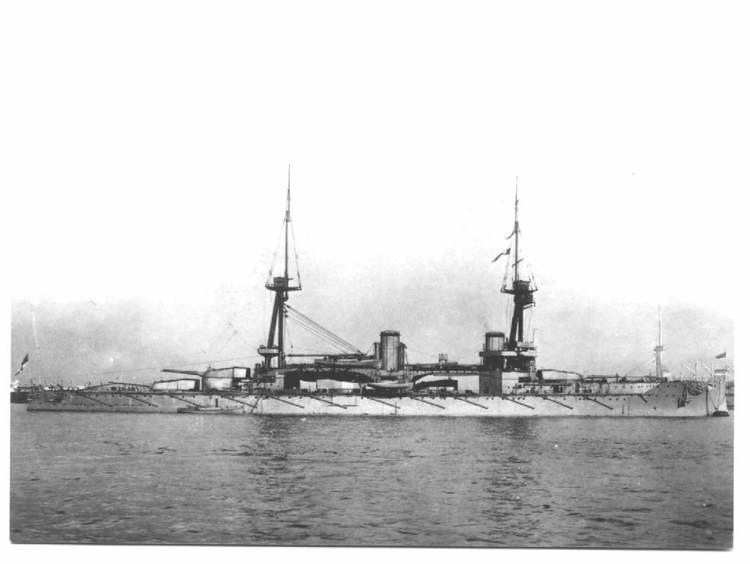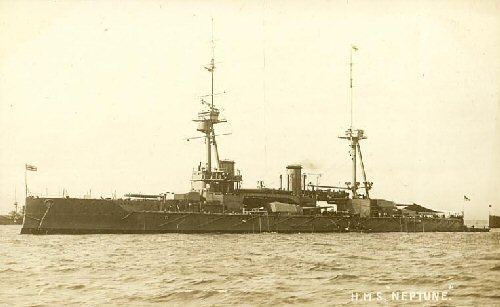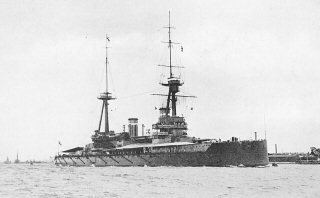In commission 1911–1921 Construction started 19 January 1909 Length 166 m Builder HMNB Portsmouth | Preceded by St Vincent class Built 1909–1911 Completed 1 Launched 30 September 1909 Draft 8.69 m | |
 | ||
Hms neptune 1909
HMS Neptune was a dreadnought battleship built for the Royal Navy in the first decade of the 20th century, the sole ship of her class. Shortly after her completion in 1911, she carried out trials of an experimental fire-control director and then became the flagship of the Home Fleet. Neptune became a private ship in early 1914 and was assigned to the 1st Battle Squadron (BS).
Contents
- Hms neptune 1909
- Background and description
- Armament and armour
- Fire control
- Modifications
- Construction and career
- First World War
- Battle of Jutland
- Subsequent activity
- References

The ship became part of the Grand Fleet when it was formed shortly after the beginning of the First World War in August 1914. Aside from participating in the Battle of Jutland in May 1916 several months later, and the inconclusive Action of 19 August, her service during the war generally consisted of routine patrols and training in the North Sea. Neptune was deemed obsolete after the war and was reduced to reserve before she was sold for scrap in 1922 and subsequently broken up.

Background and description

The only battleship of the 1908–1909 Naval Programme, Neptune was an improved version of the preceding St Vincent class with additional armour and the armament rearranged for greater efficiency. She was the first British dreadnought that differed in her gun turret layout from Dreadnought. Unlike the earlier ships, her wing turrets were staggered "en echelon" so that all five turrets could shoot on the broadside, although in practice the blast damage to the superstructure and boats made this impractical except in an emergency. Neptune was also the first British dreadnought to be equipped with superfiring turrets, in an effort to shorten the ship and reduce costs. A further saving in length was achieved by siting the ship's boats on girders over the two wing turrets to reduce the length of the vessel. However, if the girders were damaged during combat, they could fall onto the turrets, immobilising them. The bridge was also situated above the conning tower, which similarly risked being obscured if the bridge collapsed.

Neptune had an overall length of 546 feet (166.4 m), a beam of 85 feet (25.9 m), and a deep draught of 28 feet 6 inches (8.7 m). She displaced 19,680 long tons (20,000 t) at normal load and 23,123 long tons (23,494 t) at deep load. Her crew numbered about 756 officers and ratings upon completion and 813 in 1914.

The ship was powered by two sets of Parsons direct-drive steam turbines, each of which was housed in a separate engine room. The outer propeller shafts were coupled to the high-pressure turbines and these exhausted into low-pressure turbines which drove the inner shafts. The turbines used steam from eighteen Yarrow boilers at a working pressure of 235 psi (1,620 kPa; 17 kgf/cm2). They were rated at 25,000 shaft horsepower (19,000 kW) and were intended to give Neptune a maximum speed of 21 knots (39 km/h; 24 mph). During her sea trials, the ship handily exceeded her designed speed and horsepower. She carried a maximum of 2,710 long tons (2,753 t) of coal and an additional 790 long tons (803 t) of fuel oil that was sprayed on the coal to increase its burn rate. This gave them a range of 6,330 nautical miles (11,720 km; 7,280 mi) at a cruising speed of 10 knots (19 km/h; 12 mph).
Armament and armour

Neptune was equipped with ten 50-calibre breech-loading (BL) 12-inch (305 mm) Mark XI guns in five hydraulically powered twin-gun turrets, three along the centreline and the remaining two as wing turrets. The centreline turrets were designated 'A', 'X' and 'Y', from front to rear, and the port and starboard wing turrets were 'P' and 'Q' respectively. The guns had a maximum elevation of +20° which gave them a range of 21,200 yards (19,385 m). They fired 850-pound (386 kg) projectiles at a muzzle velocity of 2,825 ft/s (861 m/s) at a rate of two rounds per minute. The ship carried 100 shells per gun.
Her secondary armament consisted of sixteen 50-calibre BL four-inch (102 mm) Mark VII guns. These guns were installed in unshielded single mounts in the superstructure. Neptune was the first British dreadnought with this arrangement as the exposed turret-roof installations used in the previous dreadnoughts were difficult to work when the main armament was in action, resupply of ammunition in combat was very difficult and the guns could not be centrally controlled. The guns had a maximum elevation of +15° which gave them a range of 11,400 yd (10,424 m). They fired 31-pound (14.1 kg) projectiles at a muzzle velocity of 2,821 ft/s (860 m/s). They were provided with 150 rounds per gun. Four 3-pounder (1.9 in (47 mm)) saluting guns were also carried. The ships were equipped with three 18-inch (450 mm) submerged torpedo tubes, one on each broadside and another in the stern, for which 18 torpedoes were provided.
Neptune had a waterline belt of Krupp cemented armour that was 10 inches (254 mm) thick between the fore and aftmost barbettes that reduced to 2.5 inches (64 mm) before it reached the ships' ends. It covered the side of the hull from the middle deck down to 4 feet 4 inches (1.3 m) below the waterline where it thinned to 8 inches (203 mm) amidships. Above this was a strake of 8-inch armour. The forward oblique 5-inch (127 mm) bulkheads connected the amidships portion of waterline and upper armour belts once they reached the outer portions of the forward barbette. Similarly the aft bulkhead connected the armour belts to the rearmost barbette, although it was 8 inches thick. The three centreline barbettes were protected by armour 9 inches (229 mm) thick above the main deck and thinned to 5 inches (127 mm) below it. The wing barbettes were similar except that they had 10 inches of armour on their outer faces. The gun turrets had 11-inch (279 mm) faces and sides with 3-inch roofs.
The three armoured decks ranged in thickness from 1.25 to 3 inches (32 to 76 mm) with the greater thicknesses outside the central armoured citadel. The front and sides of the conning tower were protected by 11-inch plates, although the rear and roof were 8 inches and 3 inches thick respectively. The torpedo control tower aft had 3-inch sides and a 2-inch roof. Neptune had two longitudinal anti-torpedo bulkheads that ranged in thickness from 1 to 3 inches (25 to 76 mm) and extended from the forward end of 'A' barbette to the end of 'Y' magazine. She was the first British dreadnought to protect her boiler uptakes with 1-inch armour plates. In the vicinity of the boiler rooms, the compartments between them were used as coal bunkers.
Fire control
The control positions for the main armament were located in the spotting tops at the head of the fore and mainmasts. Data from a 9-foot (2.7 m) Barr and Stroud coincidence rangefinder located at each control position was input into a Dumaresq mechanical computer and electrically transmitted to Vickers range clocks located in the transmitting station located beneath each position on the main deck, where it was converted into range and deflection data for use by the guns. The target's data was also graphically recorded on a plotting table to assist the gunnery officer in predicting the movement of the target. The turrets, transmitting stations, and control positions could be connected in almost any combination.
Neptune was the first British dreadnought to be built with a gunnery director, albeit an experimental prototype. This was mounted on the foremast, underneath the spotting top and electrically provided data to the turrets via pointers, which the turret crew were to follow. The director layer fired the guns simultaneously which aided in spotting the shell splashes and minimised the effects of the roll on the dispersion of the shells. The ship's director was later replaced as a new director was ordered in 1913 and installed by May 1916.
Additional nine-foot rangefinders, protected by armoured hoods, were added for each gun turret in late 1914. Furthermore, the ship was fitted with Mark I Dreyer Fire-control Tables by early 1916 in each transmission station. It combined the functions of the Dumaresq and the range clock.
Modifications
Gun shields were fitted to the forward four-inch guns after September 1913 and the upper upper forward four-inch guns were enclosed. In 1914–1915, the upper amidships four-inch guns were enclosed, the forward boat girder was removed and a three-inch (76 mm) anti-aircraft (AA) gun was added on the quarterdeck. Approximately 50 long tons (51 t) of additional deck armour was added after the Battle of Jutland in May 1916. By early 1917, the total of four-inch guns had been reduced to a dozen guns by the removal of four guns from the aft superstructure and a single four-inch AA gun was added. The stern torpedo tube was removed in 1917–1918 as was the aft spotting top. A high-angle rangefinder was fitted on the remaining spotting top and a flying-off platform was installed on the 'A' turret in 1918.
Construction and career
Neptune, named after the Roman god of the sea, was ordered on 14 December 1908. She was laid down at HM Dockyard, Portsmouth, on 19 January 1909; launched on 30 September and completed in January 1911 at the cost of £1,668,916, including her armament. The ship was commissioned on 19 January 1911 for trials with an experimental director designed by Vice-Admiral Sir Percy Scott. The final trials were conducted on 11 March at Gibraltar and were witnessed by Rear-Admiral Sir John Jellicoe, commander of the Atlantic Fleet. Two weeks later, Neptune relieved Dreadnought as the flagship of the Home Fleet and of the 1st Division on 25 March and then participated in the Coronation Fleet Review at Spithead on 24 June. On 1 May 1912, the 1st Division was renamed the 1st Battle Squadron and she was relieved as the squadron's flagship on 22 June. The ship participated in the Parliamentary Naval Review on 9 July at Spithead. Neptune became a private ship on 10 March 1914 when she was replaced by Iron Duke and rejoined the 1st BS.
First World War
Between 17 and 20 July 1914 Neptune took part in a test mobilisation and fleet review as part of the British response to the July Crisis. Arriving in Portland on 27 July, she was ordered to proceed with the rest of the Home Fleet to Scapa Flow two days later to safeguard the fleet from a possible German surprise attack. In August 1914, following the outbreak of the First World War, the Home Fleet was reorganised as the Grand Fleet, and placed under the command of Admiral Jellicoe. Most of it was briefly based (22 October to 3 November) at Lough Swilly, Ireland, while the defences at Scapa were strengthened. On the evening of 22 November 1914, the Grand Fleet conducted a fruitless sweep in the southern half of the North Sea; Neptune stood with the main body in support of Vice-Admiral David Beatty's 1st Battlecruiser Squadron. The fleet was back in port in Scapa Flow by 27 November and the ship began a refit on 11 December.
On the evening of 23 January, the bulk of the Grand Fleet sailed in support of Beatty's battlecruisers, but the fleet did not participate in the ensuing Battle of Dogger Bank the following day. On 7–10 March, the Grand Fleet conducted a sweep in the northern North Sea, during which it conducted training manoeuvres. Another such cruise took place on 16–19 March; while returning home after the conclusion of the exercises, Neptune was unsuccessfully attacked by the German submarine SM U-29. On 11 April, the Grand Fleet conducted a patrol in the central North Sea and returned to port on 14 April; another patrol in the area took place on 17–19 April, followed by gunnery drills off the Shetland Islands on 20–21 April.
The Grand Fleet conducted sweeps into the central North Sea on 17–19 May and 29–31 May without encountering any German vessels. During 11–14 June the fleet conducted gunnery practice and battle exercises west of the Shetlands. and the Grand Fleet conducted training off the Shetlands beginning three days later. On 2–5 September, the fleet went on another cruise in the northern end of the North Sea and conducted gunnery drills. Throughout the rest of the month, the Grand Fleet conducted numerous training exercises. The ship, together with the majority of the Grand Fleet, conducted another sweep into the North Sea from 13 to 15 October. Almost three weeks later, Neptune participated in another fleet training operation west of Orkney during 2–5 November.
The fleet departed for a cruise in the North Sea on 26 February 1916; Jellicoe had intended to use the Harwich Force to sweep the Heligoland Bight, but bad weather prevented operations in the southern North Sea. As a result, the operation was confined to the northern end of the sea. Another sweep began on 6 March, but had to be abandoned the following day as the weather grew too severe for the escorting destroyers. On the night of 25 March, Neptune and the rest of the fleet sailed from Scapa Flow to support Beatty's battlecruisers and other light forces raiding the German Zeppelin base at Tondern. By the time the Grand Fleet approached the area on 26 March, the British and German forces had already disengaged and a strong gale threatened the light craft, so the fleet was ordered to return to base. On 21 April, the Grand Fleet conducted a demonstration off Horns Reef to distract the Germans while the Imperial Russian Navy relaid its defensive minefields in the Baltic Sea. During the night of 22/23 April, Neptune was accidentally rammed by the neutral merchant ship SS Needvaal in thick fog, but the battleship was only lightly damaged. The fleet returned to Scapa Flow on 24 April and refuelled before proceeding south in response to intelligence reports that the Germans were about to launch a raid on Lowestoft, but only arrived in the area after the Germans had withdrawn. On 2–4 May, the fleet conducted another demonstration off Horns Reef to keep German attention focused on the North Sea.
Battle of Jutland
In an attempt to lure out and destroy a portion of the Grand Fleet, the High Seas Fleet, composed of sixteen dreadnoughts, six pre-dreadnoughts and supporting ships, departed the Jade Bight early on the morning of 31 May. The fleet sailed in concert with Rear Admiral Franz von Hipper's five battlecruisers. The Royal Navy's Room 40 had intercepted and decrypted German radio traffic containing plans of the operation. In response the Admiralty ordered the Grand Fleet, totalling some 28 dreadnoughts and 9 battlecruisers, to sortie the night before to cut off and destroy the High Seas Fleet.
On 31 May, Neptune, under the command of Captain Vivian Bernard, was assigned to the 5th Division of the 1st BS and was the nineteenth ship from the head of the battle line after deployment. During the first stage of the general engagement, the ship fired two salvos from her main guns at a barely visible battleship at 18:40. After the High Seas Fleet reversed course for the first time, the ships of the 1st BS were the closest ones to the Germans; and Neptune fired one salvo at the crippled light cruiser SMS Wiesbaden about 10 minutes later. At approximately 19:10, she fired four salvos at the battlecruiser SMS Derfflinger, claiming two hits, although neither can be confirmed. Shortly afterwards, the ship fired her main and secondary guns at enemy destroyers without result and then had to turn away to dodge three torpedoes. This was the last time that Neptune fired her guns during the battle. She expended a total of 48 twelve-inch shells (21 high explosive and 27 common pointed, capped) and 48 shells from her four-inch guns during the battle.
Subsequent activity
After the battle, the ship was transferred to the 4th Battle Squadron. The Grand Fleet sortied on 18 August to ambush the High Seas Fleet while it advanced into the southern North Sea, but a series of miscommunications and mistakes prevented Jellicoe from intercepting the German fleet before it returned to port. Two light cruisers were sunk by German U-boats during the operation, prompting Jellicoe to decide to not risk the major units of the fleet south of 55° 30' North due to the prevalence of German submarines and mines. The Admiralty concurred and stipulated that the Grand Fleet would not sortie unless the German fleet was attempting an invasion of Britain or there was a strong possibility it could be forced into an engagement under suitable conditions.
On 22 April 1918, the High Seas Fleet sailed north for the last time in an unsuccessful attempt to intercept a convoy to Norway as they had to turn back two days later after the battlecruiser SMS Moltke suffered engine damage. The Grand Fleet sortied from Rosyth on the 24th when the operation was discovered, but was unable to catch the Germans. The ship was present at Rosyth when the German fleet surrendered on 21 November and Neptune was reduced to reserve on 1 February 1919 at Rosyth. The ship was listed for disposal in March 1921 and was sold for scrap to Hughes Bolckow in September 1922. She was towed to Blyth, Northumberland on 22 September to begin demolition.
